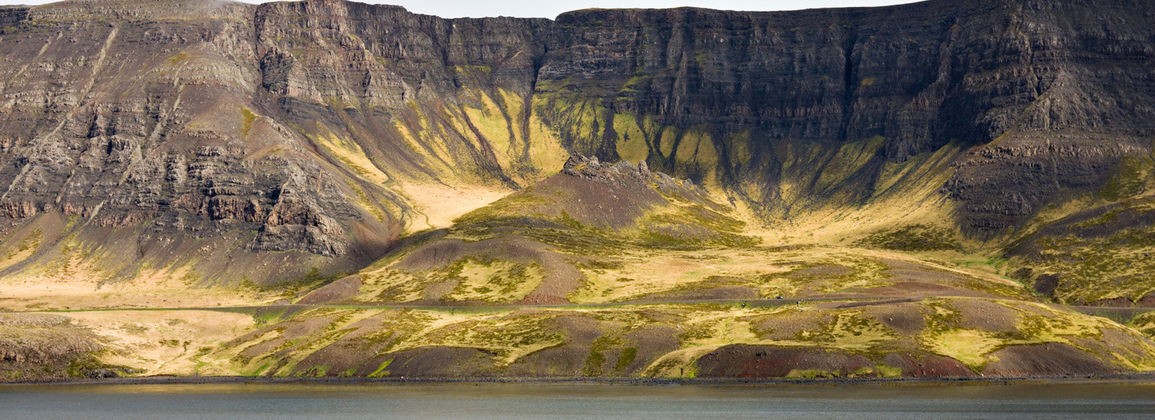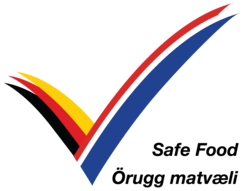The aim was to develop a Quality Index Method (QIM) scheme for fresh tilapia fillets and evaluate the scheme in a shelf life study. Farmed tilapia fillets were stored at 1 and −1 ° C for up to 20 days, and changes during storage were observed with sensory evaluation using the QIM scheme and General Descriptive Analysis (GDA), total viable counts (TVC), and hydrogen sulphide ( H2S) producing bacteria. The maximum shelf life of fillets stored at1 and −1 ° C was determined with GDA and microbial counts as 16 and 19 days, respectively. A high correlation of R2 = 0.943 between Quality Index (QI) and storage time at 1C ° was found to be 0.843 at −1 ° C. At the end of shelf life, the QI was 5.3 and 6.5 out of a maximum score of 15 for fillets stored at 1 and −1 ° C, respectively. Total viable counts and H2S-producing bacteria showed an increasing trend during storage time for both groups. At the end of shelf life, TVC was log 7 cfu / g in the flesh of both groups, with H2S producing bacteria constituting a higher proportion (log 6 cfu / g) of the total. The scheme was modified at the end of the study to better characterize deskinned farmed tilapia fillets.
Author: admin

Icelandic fresh fish exporters often use cooling mats to maintain low temperatures in fresh fish products in transport, especially air transport. The cooling mats usually contain either ice or some kind of gel, which necessarily contains such a substance that it can come into contact with the fish if the mat breaks, ie. the contents of the mat are "food-grade".
In foreign markets, the selection of cooling mats in question is wide, but in Iceland the largest sellers of cooling mats for fresh fish Promens Tempra in Hafnarfjörður and Ísgel in Blönduós. Tempra produces ice mats, which only contain water, and Ísgel produces gel mats, and it has been argued that there can be great differences in the cooling capacity of the cooling mats in question. To check this, engineering students Hilmar Arnarson and Sandra Björg Helgadóttir recently studied both the melting point and cooling capacity of ice mats from Tempru and gel mats from Ísgel in the course Fisheries Technology 2 at the University of Iceland.
In the experiment, they placed thermostats inside the cooling mats, which were packed in a foam plastic box. The boxes were placed in the freezer for a few days before standing at room temperature until the cooling mats were fully thawed. The temperature measurements did not reveal a significant difference in either the melting point of the ice and cooling mats (it was approximately 0.0 +/- 0.3 ° C) nor the cooling capacity (the ability of the cooling mats to maintain low food temperatures), see figure 1.
For further information Sigurjón Arason, professor at the University of Iceland and Matís' chief engineer.
 Figure 1. Temperature inside ice mats from Promens Tempra and gel mats from Ísgel during thawing.
Figure 1. Temperature inside ice mats from Promens Tempra and gel mats from Ísgel during thawing.
Cereal Products And Markets In The Northern Periphery Region
Preliminary projects on the cereals market and cereal products from regional cereals were carried out between September 2013 and March 2014. The project was funded by the Northern Periphery Promramme (NPP). Participants came from Iceland, Northern Norway, the Faroe Islands, Orkney and Newfoundland. The aim of the project was to: (1) Build a collaborative network on grain research. (2) Obtain information on grain production and grain utilization in each area and seek new markets and partners. (3) Draft an application for a large grain project. Participants analyzed information on grain production and grain imports. Opportunities for domestic production replaced imports. Grain markets and market developments were examined and the size of markets was assessed. It should be possible to increase domestic production of various cereals such as baked goods, cereals, pasta and alcoholic beverages. The participating countries / regions are at different levels with regard to cereal cultivation and therefore the development of cereal products must take into account the situation.
A preparatory project scoping new markets and products from local cereals in several parts of the Northern Periphery Program (NPP) area, was implemented between September 2013 and March 2014. The project included partners from the following regions: Iceland, N ‐ Norway, Faroe Islands , Orkney and Newfoundland. The project aim was to: (1) Build up a collaborative R&D network on cereals. (2) Review cereal production and utilization in each partner region and identify potential new markets and collaborators. (3) Develop a proposal for a main project. Partners quantified the domestic cereal production and import of cereals. Opportunities were found where imported cereals might be replaced by local products. Cereal markets and food trends were studied and the size of the market for cereal products was estimated. It is possible to increase the use of local cereals for the production of many foods: bakery products, breakfast cerals, pastas and alcoholic beverages. The regions differ with regard to cereal production and development of cereal products should take the situation into account.
View report

Trackwell and Matís have a long and successful collaboration and are projects like The margin manager, The Product Manager and FisHmark an example of a successful collaboration between the two companies. At the Innovation Square of the Confederation of Icelandic Industries, which was held on 23 and 24 May, Jón Ingi Björnsson, CEO of Trackwell, and Sveinn Margeirsson, CEO of Matís, signed a letter of intent for even closer cooperation.
In the above projects, and more, the Rannís Technology Development Fund has provided funding and provided financial support for the projects together with the AVS fund.
A key product of the companies' co-operation is and has been a catch registration system that Icelandic and foreign fisheries companies use to increase value creation, improve utilization and minimize the environmental impact of fishing.
It is clear that the projects that TrackWell and Matís have worked on together have given fisheries companies increased data transparency and thus facilitated the management of fishing and processing. It is important to utilize the data generated in the value chain in a systematic way to maximize the margin and profitability of the industry as a whole.
Trackwell and Matís are pleased with the current collaboration, its products and the opportunities that have been created when two powerful parties work together. The intention is to further increase the collaboration and increased emphasis will be placed on marketing issues where both parties ensure that each other's importance in joint projects is visible.

For further information Sveinn Margeirsson, CEO of Matís.

Today, a co-operation agreement was signed between Matís, Snæfellsbær, Grundarfjarðarbær and Stykkishólmsbær on support for doctoral projects Birgis Arnar Smárason in Environmental and Resource Studies at the University of Iceland. Birgir Örn works at Matís' office in Akureyri.
 From today's signature. Sveinn Margeirsson, CEO of Matís (farthest), Lárus Ástmar Hannesson, Mayor of Stykkishólmsbær, Björn Steinar Pálmason, Mayor of Grundafjaðarbær and Kristinn Jónasson, Mayor of Snæfellsbær.
From today's signature. Sveinn Margeirsson, CEO of Matís (farthest), Lárus Ástmar Hannesson, Mayor of Stykkishólmsbær, Björn Steinar Pálmason, Mayor of Grundafjaðarbær and Kristinn Jónasson, Mayor of Snæfellsbær.
The project will support the Icelandic Presidency's plan for utilization of the bioeconomy, Nordbio (@Nordbio). It is based on analyzing underused or unused raw material streams and biomaterials from the environment of Breiðafjörður. The aim is, among other things, to build a network of stakeholders in Snæfellsnes and co-operate under the auspices of environmentally friendly innovation.
For further information Sveinn Margeirsson, CEO of Matís.

Ragnheiður Elín Árnadóttir, Minister of Industry and Trade, was right to present a prize in the EcoTrophelia Ísland competition run by Matís, together with the Icelandic Innovation Center, the University of Iceland and numerous institutions at home and abroad. The award was presented at Nýsköpunartorgi Samtaka iðnaðarinn held today and tomorrow in Reykjavík University.
EcoTrophelia Iceland is part of international competition and is a product development competition among university students that involves developing environmentally friendly food. The aim of the competition is to reduce the environmental impact of Icelandic food production by creating new environmentally friendly food and beverage products. These include the use of underutilized raw materials, the use of new and environmentally friendly production methods, packaging or modes of transport. The competition is run by the Icelandic Innovation Center, Matís and the Confederation of Icelandic Industries in collaboration with Icelandic universities.
Two teams competed for the finals this year. The other team consists of Brynja Einarsdóttir, Guðjóna Björk Þorbjarnardóttir and Hrefna Lind Einarsdóttir and they had the product BEjuicy which is a freeze-dried vegetable juice in powder form. The other team consists of Christopher Melin and Páll Arnar Hauksson with the product Fjöra which is kelp mayonnaise. It so happened that the intestinal mayonnaise was chosen the winner of Ecotrophelia Iceland this time.

Ragnheiður Elín Árnadóttir, Minister of Industry and Trade, presents the EcoTrophelia Iceland 2014 award.
Fjaran mayonnaise is a fun innovation in the food market. The mayonnaise is made from Icelandic seaweed and the seaweed is sun-dried on Icelandic lava. The product is suitable for vegetarians (vegans) as well as others who are interested in adding nutrients to their diet. Further information can be found on the product's website, http://www.p.is/fjara/.
For further information Ragnheiður Héðinsdóttir, director of the food division at the Confederation of Icelandic Industries and Guðjón Þorkelsson, division manager at Matís.
Are you interested in creating a product? Matís food factories are an ideal venue.

The Innovation Square will be held at Reykjavík University on 23 and 24 May. This is a professional conference on the working environment and development process of innovative companies and an exhibition where companies and institutions present results in innovation. Nýsköpunartorgið is held in connection with the 20th anniversary of the Confederation of Icelandic Industries and the 10th anniversary of the Technology Development Fund.
PROFESSIONAL CONFERENCE
Friday 23 May at 8.45-17.00
The professional conference begins with a joint program in Sólinn, after which seminars will be held in six rooms of the university. On the one hand, there are three lines on the development process of innovative companies where companies are divided into departments according to their stage of development, and on the other hand seminars on related support services such as copyright, patents and standards. Conference guests can choose the lectures that interest them the most.
Agenda:
Joint program at 8.45-10.00
- speech - Ari Kristinn Jónsson, Rector of RU
- Sentence - Sigmundur Davíð Gunnlaugsson, Prime Minister
- Increased productivity, value creation and exports - Guðrún Hafsteinsdóttir, chairman of SI
- The state's investments in innovation - Technology Development Fund
- Operating and support systems for innovative companies - Salóme Guðmundsdóttir, Innovit Klak
Seminars at 10.10-15.00
Division 3 seminars: companies with an annual turnover of 0-10 million
- In the starting blocks - The first sale - The first development project - Initial financing
Division 2 seminars: companies with an annual turnover of 10-100 million
- Product adaptation - Continuing financing - Market structure - Process development and organization
Division 1 seminars: companies with an annual turnover of 100-1000 million
- Streamlined Management - Upscaling / Comprehensive Solutions - Growth Financing - Globalization
Seminars for service and professionals
- CE marking - Patents - Information security - Electronic commerce - Foreign co-operation and grants - Technology Development Fund - NMÍ Services - Iceland Stock Exchange - SI Services - NSA Equity Financing - Energy Management of Companies
During the lunch break there will be refreshments in the Sun. Ragnheiður Elín Árnadóttir, Minister of Industry, will present the exhibition at Nýsköpunartorg and awards will be presented at Ecotrophelia Iceland, a competition for environmentally friendly food innovation.
Following the seminars, Bjarni Benediktsson, Minister of Finance, will present the Growth Sprout's recognition. Serve light snacks.
VIEW here
Exciting INNOVATION SQUARE for the whole family
Saturday 24 May at 11.00-17.00
All those who are interested in innovation and technology will be invited to Nýsköpunartorgið. About 70 innovative companies and institutions present products and services, but in addition there will be various events for the whole family, e.g.
- Company presentations on technology opportunities - See AGENDA
- Pollapunk takes the song
- Blocked by Mindstorm
- Played with Casino Friends
- GameCreator's four winning teams introduce new video games
- Measurements of the condition of the skin available EGF skin care products
- Try cycling with the world's lightest bicycle fork
- How is electricity created?
- Innovation competition for primary school students
- Real or fake? Fake products on display
- Take part in an innovation on Sky's word wall where you search for Icelandic in English computer terms
- and more fun…
VIEW exhibitors
Admission to the show is free.
Objectives The objectives of Nýsköpunartorg are to create a clear picture of the success and development of the technology and intellectual property industry and the involvement of the support system and the Technology Development Fund and to this development as well as to build a strong and positive image of these companies by showing and reporting innovation in different companies.
The Confederation of Icelandic Industries, Tækniþróunarsjóður, RU, Einkaleyfastofa and Ský and other parties related to the innovation environment in Iceland are responsible for Nýsköpunartorgin.
More information can be found at website of the Confederation of Icelandic Industries.

Matís, Promens, Thor Ice, Sjávarútvegsklasi Vestfjarði, Eimskip and Samskip are collaborating on a project that involves transporting fresh fish products in pots and boxes and are looking for two students in master's studies or who are on their way to master's studies.
These are two master's projects and the possible scope of both is 30–60 ECTS (one to two semesters). The projects are particularly suitable for master's students in mechanical / industrial engineering, food or business. AVS Fisheries Research Fund (www.avs.is) covers the costs of the master's projects listed below.
Task 1-goal
Economic comparison of different packaging and transport methods for fresh fish products from Iceland to markets in Europe and America. The analysis takes into account the cost of different processing cooling methods, packaging, transport and deterioration of products. An accurate assessment of the volume utilization of refrigerated containers during transport in boxes on the one hand and pots on the other is part of the project.
Task 2-goal
Estimate the optimal amount and type (salt and ice ratio) of an ice scraper in a 340 L food vessel by experiment and / or heat transfer modeling with a target fish temperature of -1.0 ° C. This will be done for two possible cases of ambient temperature in the container transport of containers, i.e. -0.5 ° C and 3 ° C and two possible initial fish temperatures, i.e. 0 ° C and 5 ° C. It also involves finding the minimum amount and ice percentage of ice scrapers that need to be used in pots that are exposed to significant heat stress (higher ambient temperatures).
Working hours: May 2014 – April 2015
For further information, please contact Sigurjón Arason, Professor at the University of Iceland and Matís' Chief Engineer (sigurjon.arason@matis.is) and dr. Björn Margeirsson, Research Director of Promens (bjorn.margeirsson@promens.com).

Matvælastofnun's consultation meeting was held yesterday, but the consultation meeting is a forum for Matvælastofnun, regulators and other customers of the agency to strengthen communication between themselves and present views in an interactive way.
Helga Gunnlaugsdóttir, Matís' director at the congress, reviewed product safety and also discussed a new laboratory in Matís' premises, but the opening of the laboratory on Matís' news website is discussed in detail.

Further information about the consultation session can be found on the website of the Food Administration, www.mast.is, but further information about the new laboratory and the Safe Food project can be found on Matís' website, www.matis.is.

The occasion was the opening of a magnificent laboratory at Vínlandsleið 12 in Reykjavík, which was set up as part of the collaborative project Safe Food.
The Minister of Fisheries and Agriculture, Sigurður Ingi Jóhannsson, was present at the opening, along with the German Ambassador to Iceland, Thomas Hermann Meister, both of whom gave short speeches and formally opened the laboratory with clippings. Ágústa Guðmundsdóttir, who sits on the board of Matís, also gave a good speech about the importance of the research facility for the public, for Icelandic food production and for Matís and how the facility will be used in, among other things, studies in food and nutrition at the University of Iceland.

Minister of Fisheries and Agriculture, Sigurður
Ingi Jóhannsson and the German Ambassador to Iceland,
Thomas Hermann Meister, formally open the facility.
The Safe Food project is intended to ensure food safety and protect Icelandic consumers. The project enables the Icelandic authorities, the Food Administration and the municipal health inspectorate to better enforce legislation on food safety and consumer protection. Safe food is developed in collaboration with Matís, Matvælastofnun, the Ministry of Industry and Innovation, the Federal Ministry of Food and Agriculture (BMEL), the Federal Institute for Risk Assessment (BfR) and the Lower Saxony State Office for Consumer Protection and Food Safety (LAVES) in Germany.
With the opening of the research facility and with improved equipment, it will be possible to carry out much more measurements domestically than is currently the case, such as measurements of algae toxins in shellfish and measurements of 300 pesticides in food instead of the 60 currently measured.
The Safe Foods project will undoubtedly be a great springboard for Icelandic consumers, regulators and not least for producers and retailers. Consumers want more information about the substances that are and are not in the foods they consume and manufacturers and retailers also want this information to further increase consumer confidence in their products.
For further information Helga Gunnlaugsdóttir, director of Matís.

